Seismic Response Variance of Depositional Sequences: Implications for Reservoir Prediction in Lacustrine Basin
Abstract
:1. Introduction
2. Geological Setting
3. Data and Methods
4. Results
4.1. Facies Interpretation in Different Depositional Sequences
4.1.1. Depositional Facies of the Lower Sandstone Section
4.1.2. Depositional Facies of the Upper Mudstone Section
4.1.3. Vertical Style of Depositional Sequences
4.2. Seismic Responses of Different Vertical Depositional Sequences
4.2.1. Forward Simulation Based on Different Sand and Mudstone Combination Styles
4.2.2. Wavelet Decomposition and Reconstruction
4.2.3. RMS Amplitude Attribute
5. Discussion
5.1. Distribution Characteristics of Sandstone in District
5.2. Distribution Model of Thin Sand Bodies in the Upper Mudstone Section
6. Conclusions
- The Baxigai Formation in the western part of Tabei Uplift mainly develops with braided river delta deposits. The lower sandstone section develops with thick sandstone and finger-shaped sandstone in distributary channels. The sandstone in the upper mudstone section gradually pinches out from southeast to northwest, and an isolated thin layer of beach bar sandstone is developed in coastal areas.
- Based on the spatial distributions of the lower sandstone section and the upper mudstone section, five combination styles were identified: thin-layer upper mudstone–thick sandstone; medium-thick-layer upper mudstone–medium-thick sandstone; medium-thick-layer upper mudstone–thin-layer sandstone-block sandstone; medium-thick-layer upper mudstone–thin-layer sandstone–finger-shaped sandstone; and thick-layer upper mudstone–finger-shaped sandstone.
- Five seismic forward modeling models were established according to the sandstone–mudstone combination style. The results correspond to four different seismic responses. Using wavelet decomposition and reconstruction techniques, multi-wavelet series was determined in the medium- to high-frequency range. The seismic amplitude variation characteristics of sandstone–mudstone combinations related to thin sandstone were determined. The RMS amplitude attribute was optimized to complete the prediction of sandstone distribution.
- Based on the seismic prediction of thin sandstone distribution, the sedimentary model of thin-bedded sandstone in the upper mudstone section of the Baxigai Formation was established. During the sedimentation period of the lower sandstone section, the delta rapidly progrades toward the lacustrine basin. In the proximal location, the sand bodies are continuously developed and relatively thick. At the distal part in the downflow direction, the thickness of the sand body varies greatly, appearing as a finger shape in profile. During the depositional period of the upper mudstone section, the scale of the delta decreased. Deltaic deposits were transported by waves and coastal currents to form beach bars.
- The thin sand bodies in the upper mudstone section of the Cretaceous Baxigai Formation in the western Tabei Uplift could form lithologic traps, which have important exploration and development value for lithologic oil reservoirs. The thin beach bar sandstone is pinched out in the upward tilt direction, forming a favorable zone of the lithologic traps.
Author Contributions
Funding
Data Availability Statement
Conflicts of Interest
References
- Geronimo, J.S.; Hardin, D.P.; Massopust, P.R. Fractal functions and wavelet expansions based oil several scaling functions. J. Approx. Theory 1994, 78, 373–401. [Google Scholar] [CrossRef]
- Jonathan, M.; Lilly, J.P. Multiwavelet spectral and polarization analyses of seismic records. Geophys. J. Int. 1995, 122, 1001–1021. [Google Scholar]
- Xu, T.; Shen, Z.; Wen, X. Research and application of multi-wavelet decomposition and reconstructing technology. J. Chengdu Univ. Technol. 2010, 3, 660–665. [Google Scholar]
- Dai, S.H.; Chen, Z.G.; Yu, J.B.; Xie, J.L.; Mao, F.J.; Wei, T.C.; Li, Y.B. Application of multi-wavelet decomposition and reconstruction technigue in reservoir characterization in TKT-NGS Oilfield, Algeria. Oil Geophys. Prospect. 2011, 46, 103–109. [Google Scholar]
- Xiong, X.; Gong, S.; Cui, Z.F.; Jian, S.K.; Huang, J. Improved wavelet decomposition method and its application. Prog. Geophys. 2018, 33, 1617–1621. [Google Scholar]
- Xiang, L.; Li, D. Eliminating seismic shielding of igneous rock using wavelet decomposition and seismic cycle analysi. Geol. Sci. Technol. Inf. 2016, 35, 210–215. [Google Scholar]
- Xie, C.; Huang, W.; Guan, X.; Gu, H.; Xu, L. Thin sand identification under strong reflection with volume-based waveform decomposition. Oil Geophys. Prospect. 2017, 5, 516–520. [Google Scholar]
- Li, K.; Zheng, X.; Zhao, H.; Yang, Z.; Zhou, L. Application of reconstructed seismic data volume technology based on wave-form decomposition in prediction of thin tight oil reservoir. Pet. Geol. Oilfield Dev. Daqing 2022, 41, 131–137. [Google Scholar]
- Wang, X.; Fan, S.; Ren, Y.; Xu, B.; Liu, X. Multi-attribute regression and neural network series inversion to predict thin reservoirs. Xinjiang Pet. Geol. 2013, 34, 324–327. [Google Scholar]
- Xiong, R.; Zhao, J.; Hou, G. Prediction of thin sandstone reservoirs by spectral decomposition and seismic peak attribute analysis. Xinjiang Pet. Geol. 2013, 34, 225–227. [Google Scholar]
- Ni, C.; Su, M.; Liu, H.; Cai, G.; Branch, N. Discussion on the application conditions and resolution of stratigraphic slices. Nat. Gas Geosci. 2014, 25, 1830–1838. [Google Scholar]
- Chen, W.; Wang, Z.; Hou, J.; Wei, C. Application of stratigraphic sectioning technology in sedimentary facies research. Oil Geophys. Explor. 2015, 50, 1007–1015. [Google Scholar]
- Gu, W.; Xu, M.; Wang, D.; Zheng, H.; Zhang, X.; Zhang, D.; Luo, J. Application of seismic waveform indication inversion technology in thin reservoir prediction-a case study of thin sandstone gas reservoirs in B area of Junggar Basin. Nat. Gas Geosci. 2016, 27, 2064–2069. [Google Scholar]
- Gao, J.; Bi, J.; Zhao, H.; Fu, Z.; Amp, S.E. Seismic waveform indication inversion thin reservoir prediction technology and its application. Prog. Geophys. 2017, 32, 142–145. [Google Scholar]
- Guo, X.; Li, X.; Li, B.; Yang, Y.; Jiang, S.; Xu, J. Multi-attribute fusion method is used to predict the thin sandstone reservoir of Wutonggou Formation in Dixi 178 well area, Xinjiang. Nat. Gas Geosci. 2018, 29, 1172–1180. [Google Scholar]
- Peng, J.; Zhou, J.; Ma, G.; Sui, B.; Wang, Y.; Tang, X. Application of high-precision three-parameter wavelet spectral analysis in thin reservoir prediction. Xinjiang Pet. Geol. 2018, 39, 230–235. [Google Scholar]
- Chen, Y.; Bi, J.; Qiu, X. A method of seismic meme inversion and its application. Pet. Explor. Dev. 2020, 47, 1235–1245. [Google Scholar] [CrossRef]
- Zhou, L.; Qian, Y.; Wu, Y.; Zhang, L.; Lan, X.; Wang, Y.; Zhong, G. Seismic prediction of thin oolitic shoal reservoirs constrained by favorable facies belts-A case study of the second member of Feixianguan Formation in Jiulongshan area, northwestern Sichuan. Gas Geosci. 2021, 32, 1532–1545. [Google Scholar]
- Xiong, X.; Luo, H.; Xiao, Y.; Zhang, M. Thin reservoir prediction of Permian Qixia Formation in central Sichuan based on waveform indicator inversion method. Prog. Geophys. 2022, 37, 2460–2468. [Google Scholar]
- Zhang, Z.; Lin, C.; Liu, Y. Lacustrine to fluvial depositional systems: The depositional evolution of an intracontinental depression and controlling factors, Lower Cretaceous, Northern Tarim Basin, Northwest China. Mar. Pet. Geol. 2021, 126, 104904. [Google Scholar] [CrossRef]
- Sun, D. Quantitative evaluation the physical properties evolution of sandstone reservoirs constrained by burial and thermal evolution reconstruction: A case study from the Lower Cretaceous Baxigai Formation of the western Yingmaili Area in the Tabei Uplift, Tarim Basin, NW China. J. Pet. Sci. Eng. 2022, 208, 109460. [Google Scholar]
- Zhao, H.; Sun, Q.; Li, W.; Gao, D.; Zhao, F.; Lu, S.; Zhu, P. Cretaceous hydrocarbon accumulation rules in Yingmaili area of Tabei Uplift-Taking Yingmai 46 well area as an example. J. China Univ. Min. Technol. 2022, 5, 137–147. [Google Scholar]
- Yang, H.; Liu, Y.; Su, Z.; Han, J. Main controlling factors for the formation of high-quality reservoirs of deep clastic rocks in the Tabei Uplift. Geol. Rev. 2020, 6, 169–179. [Google Scholar]
- Xu, Z.; Shi, W.; Wang, R.; Luo, F.; Xia, Y.; Tan, S.; Zhang, X. Oil and gas accumulation rules and models of Cretaceous clastic rocks in western Tabei Uplift. Lithol. Reserv. 2023, 35, 31–46. [Google Scholar]
- Su, Z.; Liu, Y.; Han, J.; Luo, H.; Yang, F.; Cui, Y.; Peng, P.; Zhang, H.; Du, L.; Liu, Z. Application of ultra-deep thin sand body prediction technology under facies-controlled constraints in Yudong block of Tabei Uplift. Gas Geosci. 2020, 31, 295–306. [Google Scholar]
- Bashir, Y.; Faisal, M.A.; Biswas, A.; Babasafari, A.A.; Ali, S.H.; Imran, Q.S.; Siddiqui, N.A.; Ehsan, M. Seismic expression of miocene carbonate platform and reservoir characterization through geophysical approach: Application in central Luconia, offshore Malaysia. Pet. Explor. Prod. Technol. 2021, 11, 1533–1544. [Google Scholar] [CrossRef]
- He, B.; Jiao, C.; Liu, R.; Cao, Z.; Cai, Z.; Lan, M.; Run, X.; Zhu, D.; Jiang, Z.; Yang, Y. Neoproterozoic Paleostructure-Paleogeography and Prediction of Deep Favorable Source Rock Development Areas in Tarim Basin. Geosci. Front. 2023, 30, 19–42. [Google Scholar]
- Tian, J. Oil and Gas Exploration Achievements and Exploration Direction. Xinjiang Pet. Geol. 2019, 40, 1–11. [Google Scholar]
- Wu, G.; Zhang, Z.; Lin, C.; Tian, N.; Zuo, X.; Li, H.; Kong, F.; Li, J. Sedimentary Evolution Characteristics of Mesozoic in Tabei Uplift Area, Tarim Basin. Oil Gas Geol. 2022, 43, 845–858. [Google Scholar]
- Jia, C. Structural Features and Oil and Gas in Tarim Basin, China; Petroleum Industry Press: Beijing, China, 1997; pp. 1–438. [Google Scholar]
- He, D.; Zhou, X.; Yang, H.; Guan, S.; Zhang, C. Genetic mechanism and tectonic type of paleo-uplifts in the craton of Tarim Basin. Geol. Front. 2008, 15, 207–221. [Google Scholar]
- Xu, G.; Lin, C.; Liu, Y.; Qi, S. Paleo-uplift evolution and its control on sedimentation during the deposition of the Early Cretaceous Kapushaliang Group in western Tabei. Earth Sci. 2016, 41, 619–632. [Google Scholar]
- Li, J.; Wu, G.; Lin, C.; Liu, Y.; Liu, J.; Sun, Q.; Li, H.; Xu, G. Control of stratigraphic traps by unconformity triangle zone in paleo-uplift slope area - A case study of Cretaceous in western Tabei Uplift. J. Northeast. Pet. Univ. 2019, 43, 68–78. [Google Scholar]
- Wu, G.; Lin, C.; Yang, H. Major unconformities in the Mesozoic sedimentary sequences in the Kuqa–Tabei region, Tarim Basin, NW China. J. Asian Earth Sci. 2019, 183, 103957.1–103957.16. [Google Scholar] [CrossRef]
- Chen, G.; Huang, Z.; Zhan, H.; Zhang, R.; Yan, X. Provenance analysis of clastic rocks in the Cretaceous Bashijiqike Formation at Kuqa depression. Nat. Gas Geosci. 2012, 23, 1025–1033. [Google Scholar]
- Luo, H.; Chen, J.; Zhang, X.; Meng, X.; Zhao, F.; Wu, S.; Guo, X. Sedimentary characteristics of fluvial dominated shallow water delta front and its control on lithologic reservoir: A case study of Baxigai Formation in south slope of Kuqa Depression. Lithol. Reserv. 2021, 33, 70–80. [Google Scholar]
- Liu, J.; Wang, P.; Chen, J.; Meng, X. Identification of the Cretaceous sandbody pinchout line in the south of Kuqa Dpression, China, via seismic sedimentology. Geophys. Prospect. Peroleu 2018, 57, 788–794. [Google Scholar]
- Chen, R.; Tong, S.; Liu, H.; Zhu, J. Reservoir prediction technology based on wavelet decomposition and reconstruction. Mar. Geol. Front. 2014, 30, 55–61. [Google Scholar]
- Chen, C. Research on Seismic Multiwavelet Decomposition and Reconstruction Technology Based on Matching Pursuit Algorithm; Northeast Petroleum University: Daqing, China, 2015. [Google Scholar]
- Liu, C.; Chen, S.; Zhao, J.; Chen, G.; Su, Z.; Gao, Q. Conditions of distal hydrocarbon accumulation and main controlling factors of enrichment-A case study of Mesozoic-Cenozoic reservoirs in the southern slope of Kuqa depression. Pet. J. 2021, 42, 307–318. [Google Scholar]
- Wu, G.; Lin, C.; Liu, Y.; Liu, J.; Yang, X.; Li, H. The main unconformity and paleo-uplift geomorphological characteristics of the key Mesozoic transformation period in Kuqa-Tabei area. Oil Gas Geol. 2019, 40, 763–777. [Google Scholar]
- Zhao, H.; He, Q.; Yuan, R.; Yi, Z.; Li, B.; Yang, S.; Shi, F.; Liu, L. Sequence stratigraphic filling model of the Cretaceous in the western Tabei Uplift, Tarim Basin, NW China. Open Geosci. 2022, 14, 1137–1146. [Google Scholar] [CrossRef]
- Xue, H.; Han, C.; Xiao, B.; Wang, F.; Li, L. Sedimentary characteristics and model of shallow-water delta front in the lower submember of the first member of Shahejie Formation in Gaoyang area of Lixian slope. Lithol. Reserv. 2020, 32, 69–80. [Google Scholar]
- Wu, J.; Zhu, C.; Yang, G.; Zhao, J.; Gong, Q.; Song, G. High-resolution sequence stratigraphic characteristics and sedimentary evolution of thin-layer sandstone under high-frequency lake level changes—A case study of the bottom sandstone member of the Kumugeliemu Group in the Wensu uplift-Yingmaili uplift area. Oil Gas Geol. Recovery 2020, 27, 38–46. [Google Scholar]
- Liu, J.; Ji, Y.; Yang, K.; Zhou, Y.; Chen, X.; Gao, C.; Jia, L. Sand control mechanism of delta shoreline in shallow lake basin and its significance for oil and gas exploration-a case study of Penglaizhen Formation in the middle part of Western Sichuan Depression. Pet. J. 2015, 36, 1060–1073. [Google Scholar]
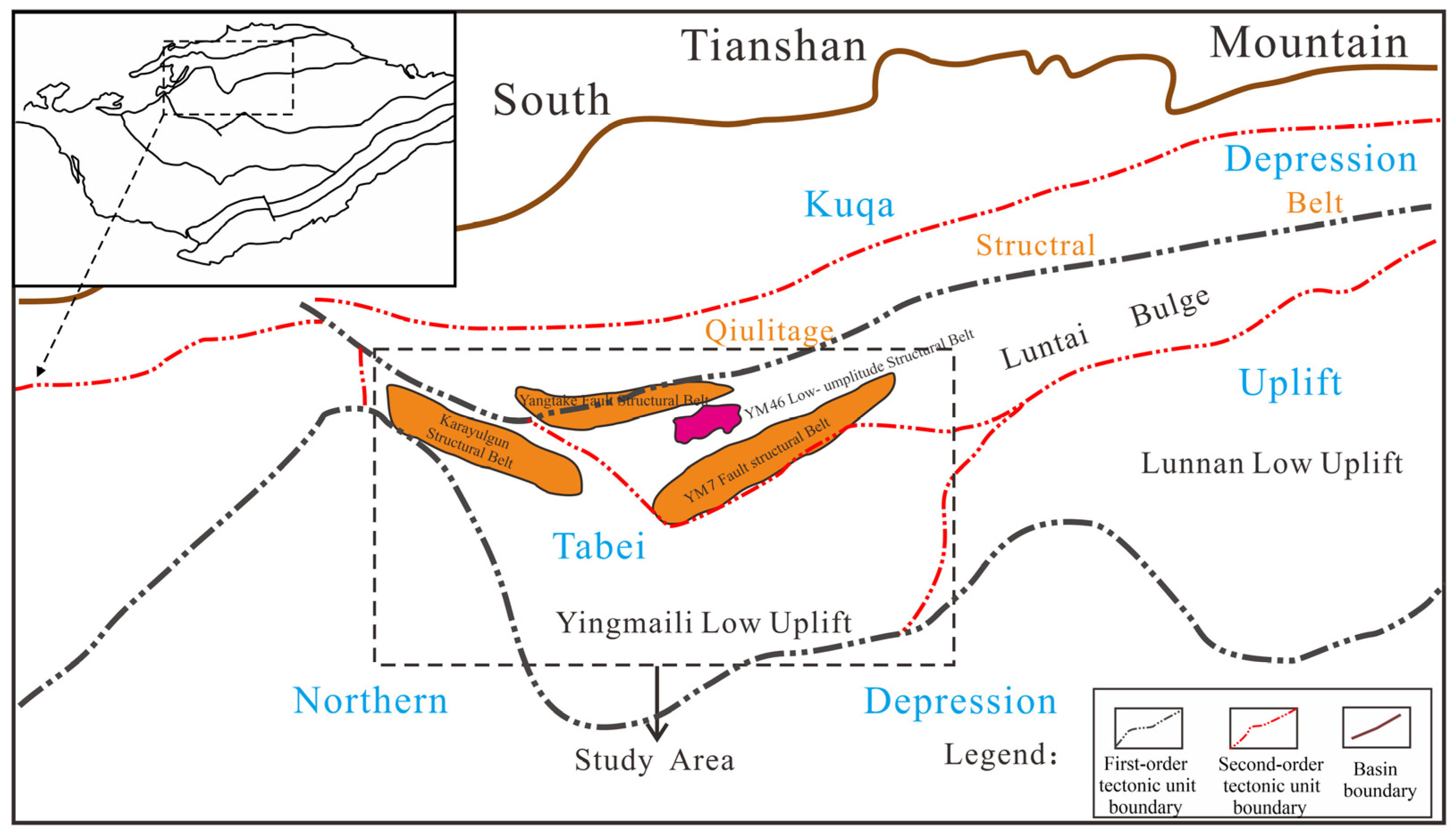




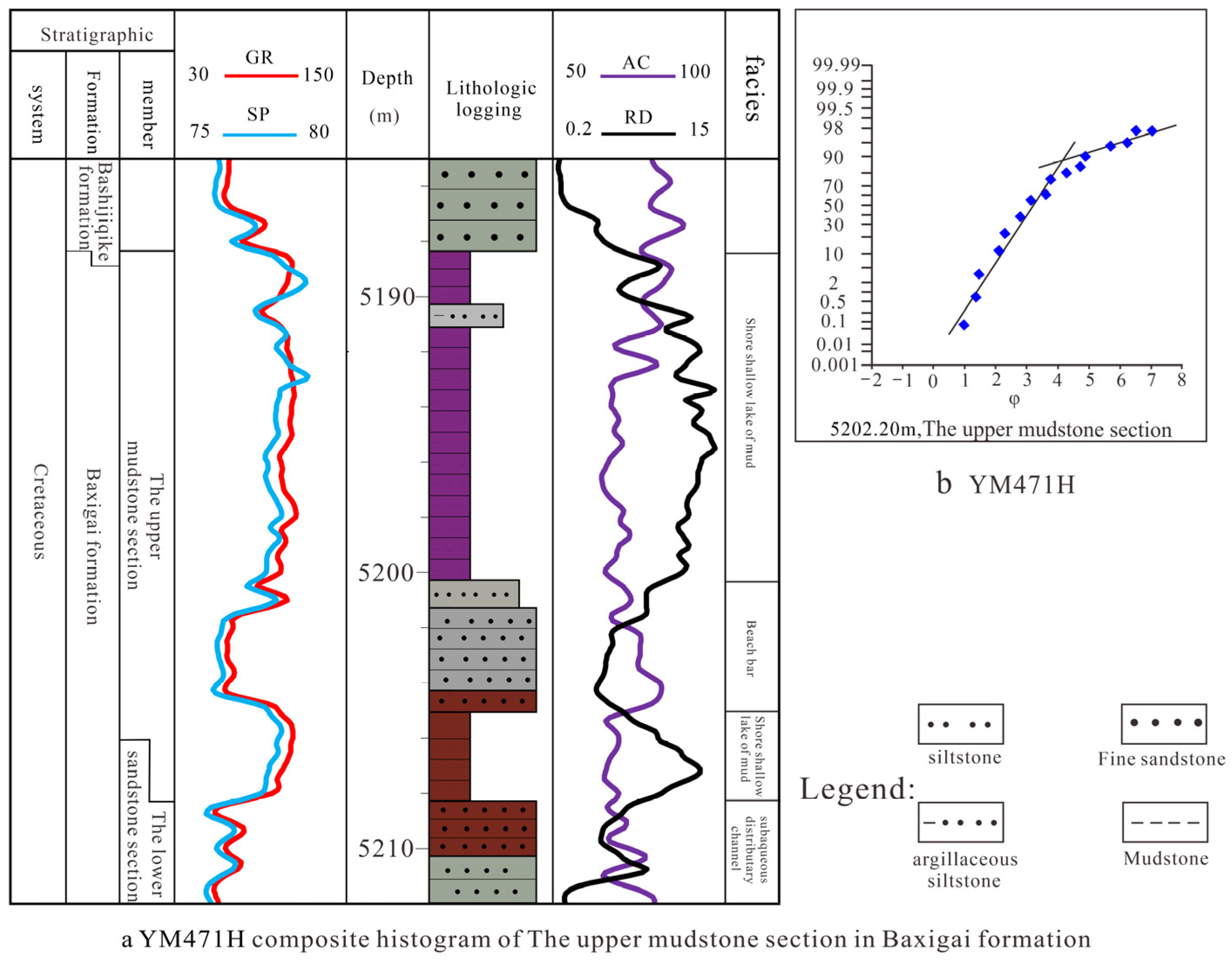

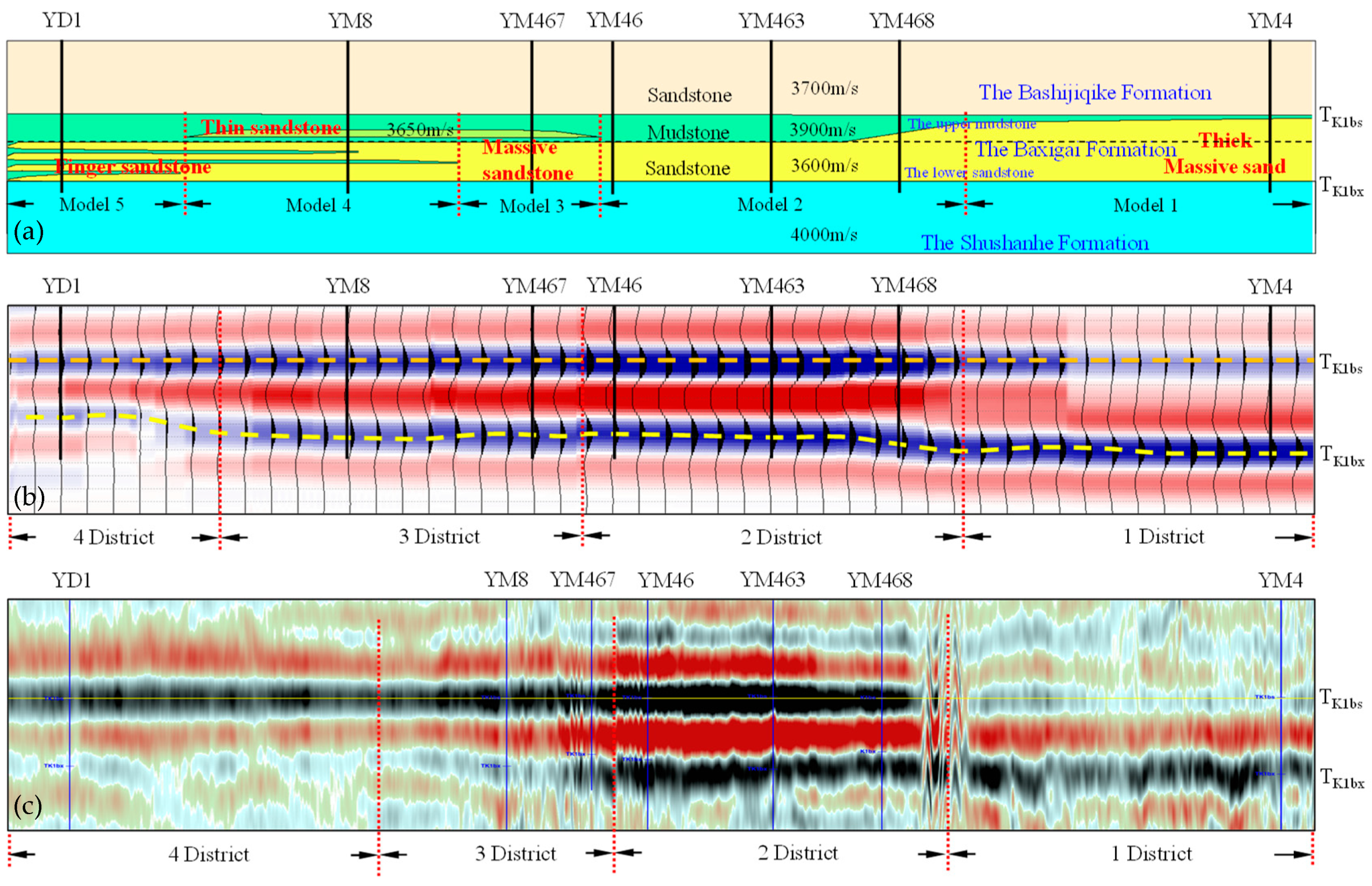


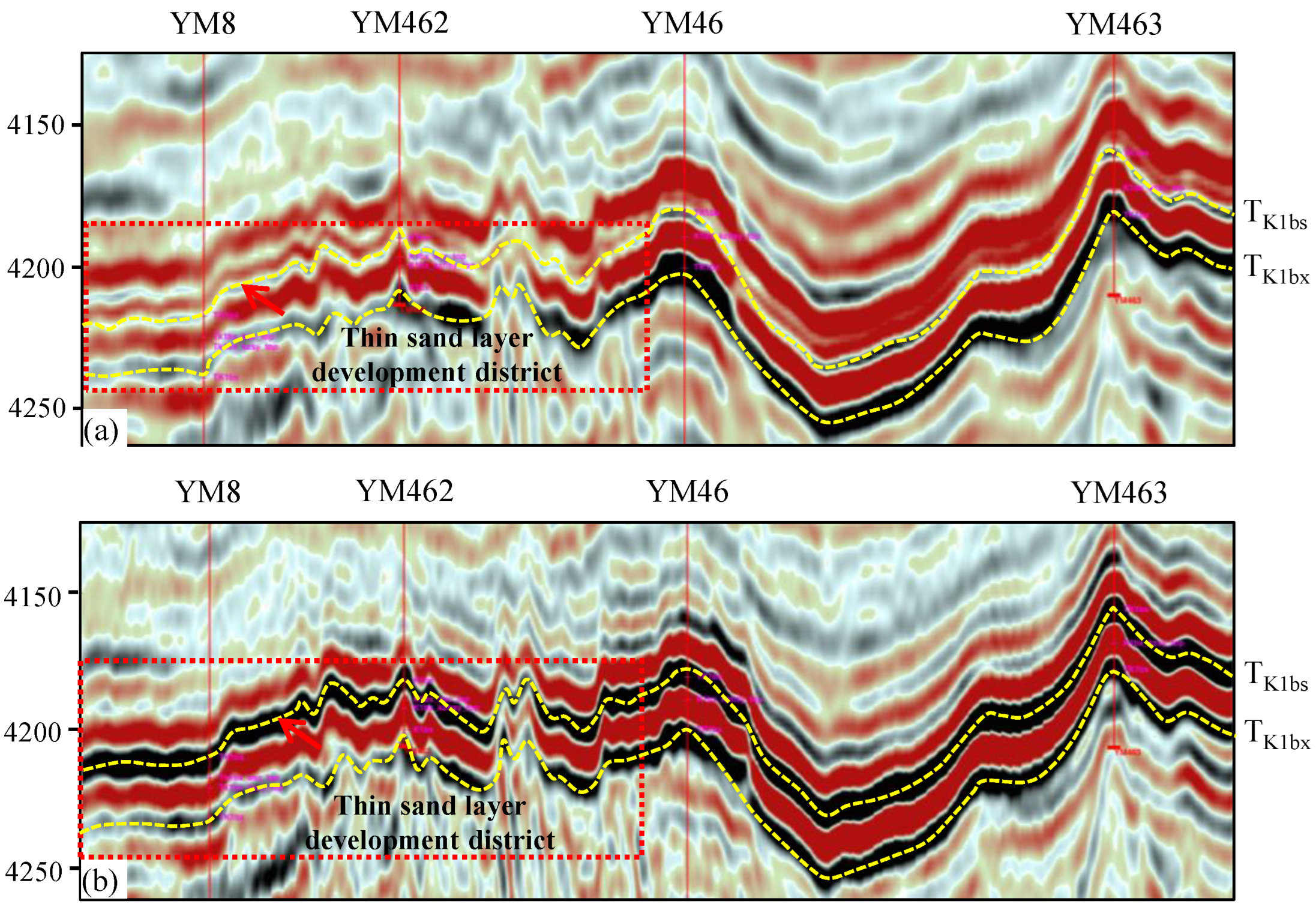
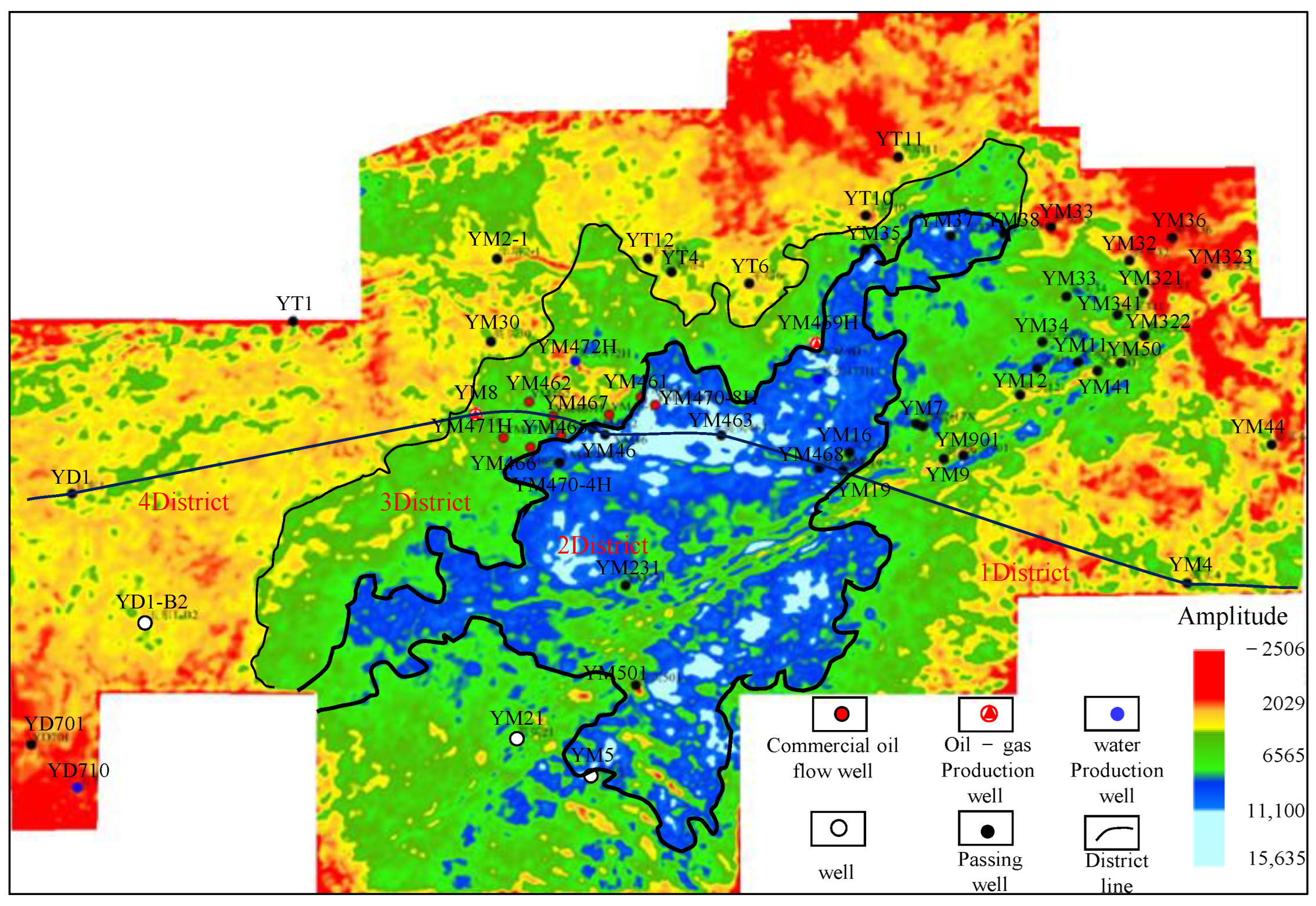
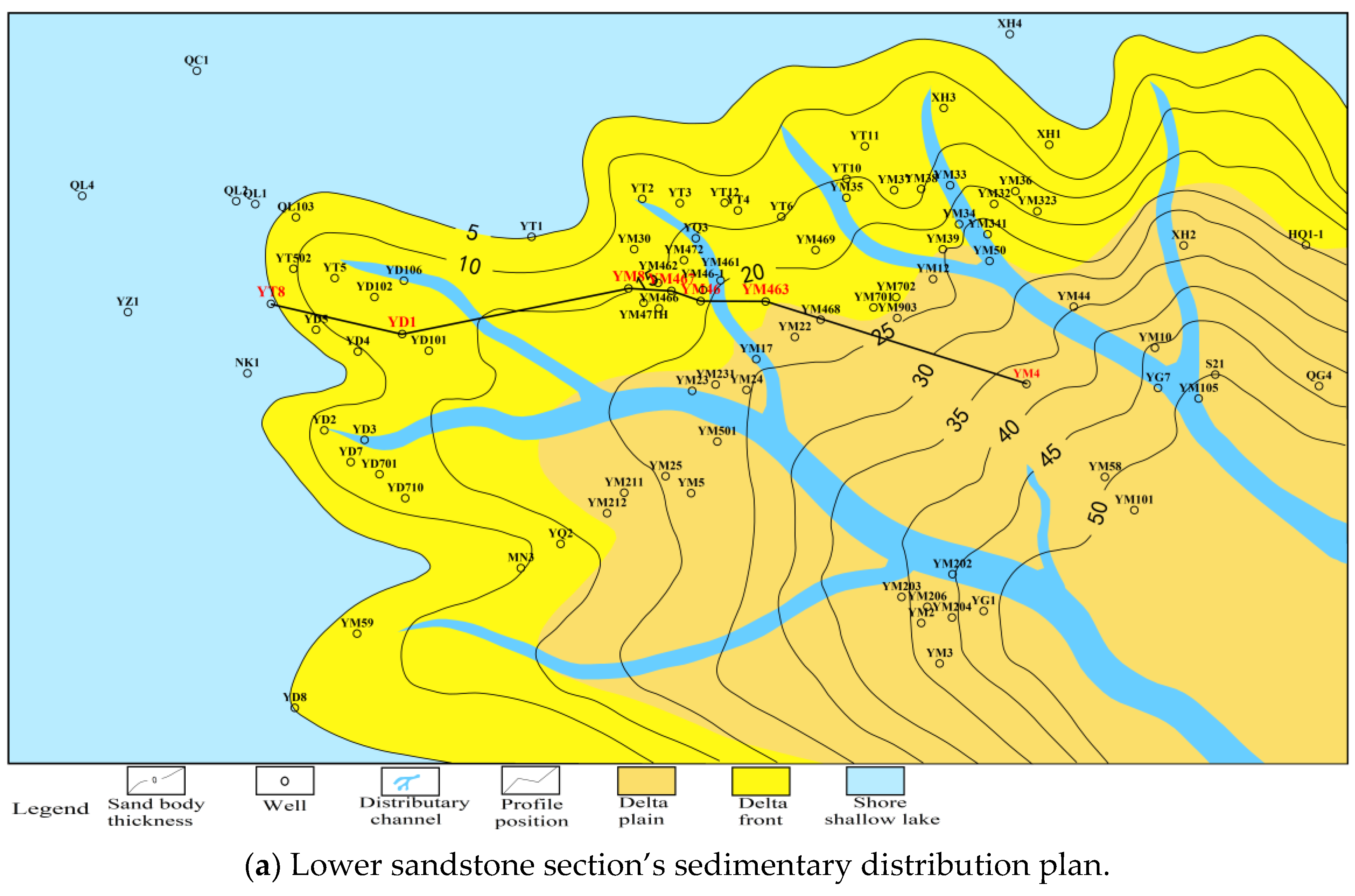

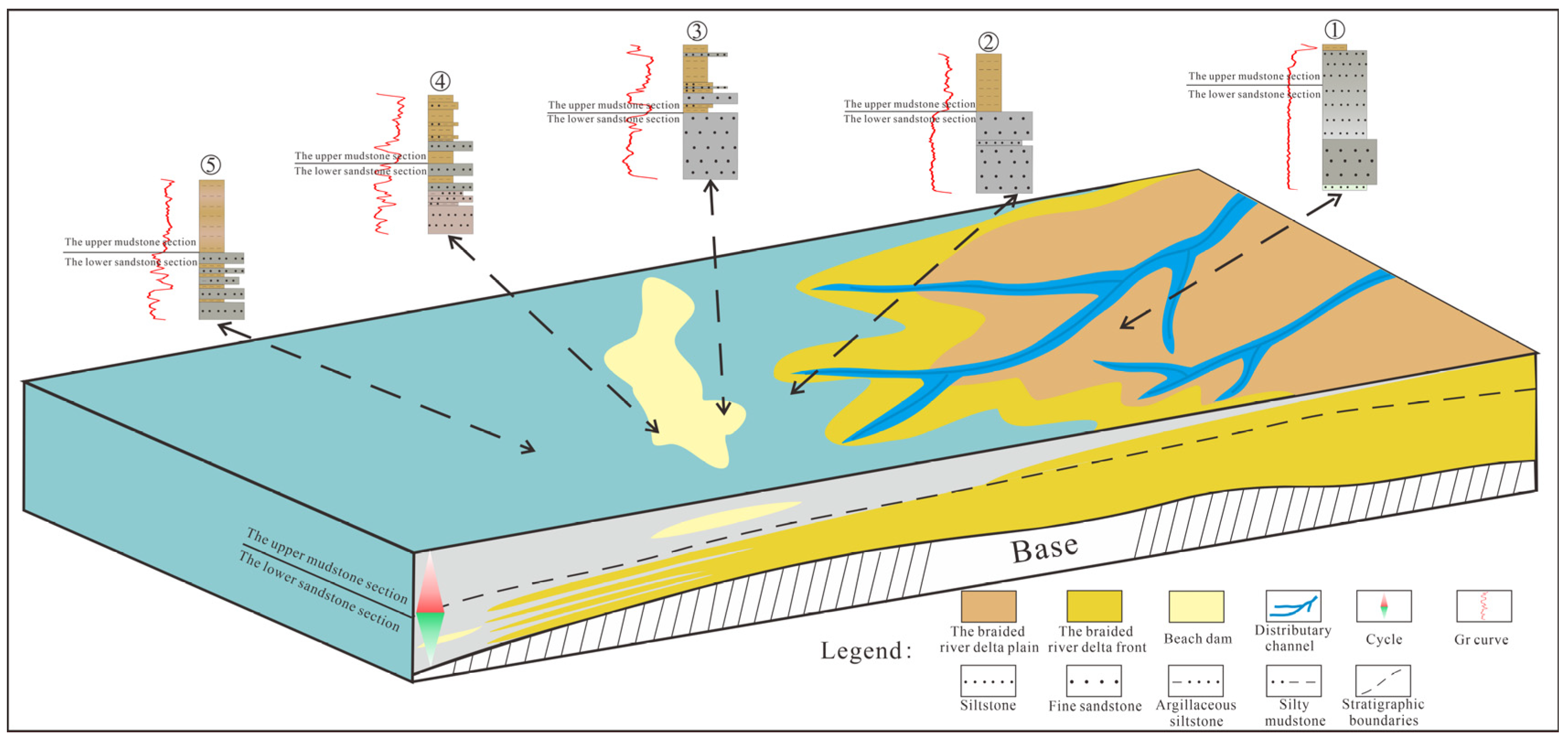
Disclaimer/Publisher’s Note: The statements, opinions and data contained in all publications are solely those of the individual author(s) and contributor(s) and not of MDPI and/or the editor(s). MDPI and/or the editor(s) disclaim responsibility for any injury to people or property resulting from any ideas, methods, instructions or products referred to in the content. |
© 2023 by the authors. Licensee MDPI, Basel, Switzerland. This article is an open access article distributed under the terms and conditions of the Creative Commons Attribution (CC BY) license (https://creativecommons.org/licenses/by/4.0/).
Share and Cite
He, Q.; Yang, S.; He, W.; Hu, Y.; Wang, T.; Gao, X. Seismic Response Variance of Depositional Sequences: Implications for Reservoir Prediction in Lacustrine Basin. Processes 2023, 11, 2481. https://doi.org/10.3390/pr11082481
He Q, Yang S, He W, Hu Y, Wang T, Gao X. Seismic Response Variance of Depositional Sequences: Implications for Reservoir Prediction in Lacustrine Basin. Processes. 2023; 11(8):2481. https://doi.org/10.3390/pr11082481
Chicago/Turabian StyleHe, Qiaolin, Shuwen Yang, Wenxiang He, Yong Hu, Tong Wang, and Xiaoyang Gao. 2023. "Seismic Response Variance of Depositional Sequences: Implications for Reservoir Prediction in Lacustrine Basin" Processes 11, no. 8: 2481. https://doi.org/10.3390/pr11082481
APA StyleHe, Q., Yang, S., He, W., Hu, Y., Wang, T., & Gao, X. (2023). Seismic Response Variance of Depositional Sequences: Implications for Reservoir Prediction in Lacustrine Basin. Processes, 11(8), 2481. https://doi.org/10.3390/pr11082481








